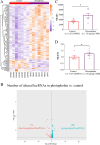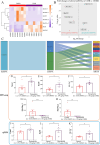Nuclear paraspeckle assembly transcript 1 promotes photophobia behavior in mice via miR-196a-5p/Trpm3 coupling
- PMID: 40399770
- PMCID: PMC12096706
- DOI: 10.1186/s10194-025-02057-5
Nuclear paraspeckle assembly transcript 1 promotes photophobia behavior in mice via miR-196a-5p/Trpm3 coupling
Abstract
Background: The long noncoding RNA, NEAT1, is recognized as a key regulator of proinflammatory gene expression; Yet, its functional role in migraine remains unexplored, despite the central role of neuroinflammatory mechanisms in migraine pathophysiology. This study examines the implication of NEAT1 in the trigeminal ganglion activation, which underlies photophobia associated with migraine.
Methods: Light aversion behavior was induced by intranasal injection of the TRPA1 activator, umbellulone. Male mouse behavior was assessed by the total time the mouse stays in the light between the dark and light compartments. To gain insight to the NEAT1-mediated photophobia mechanism, gene expression of candidate genes and non-coding RNAs interactions were assessed using RNA-sequencing, qPCR analysis, histology and dual-luciferase reporter gene assay.
Results: NEAT1 was upregulated in the trigeminal ganglion of male photophobia mice; Downregulation of NEAT1 by intravenous injection of shNEAT1 adeno-associated virus vectors attenuated NEAT1 expression and alleviated photophobia-like behavior in mice. The elevated NEAT1 expression in the trigeminal ganglion of photophobia mice corresponds to the downregulation of miR-196a-5p and upregulation Trpm3 RNA level. Predicted analysis suggested NEAT1/miR-196a-5p ceRNA network exists in photophobia mice. Indeed, knocking down NEAT1 upregulated miR-196a-5p, whilst downregulated Trpm3 gene expression level, in the trigeminal ganglion of photophobia mice. Further investigation using dual-luciferase reporter gene assay identified NEAT1 interacting with miR-196a-5p, whilst miR-196a-5p interacting with Trpm3. Similar to knocking down NEAT1, TRPM3 inhibition reduced photophobia-like behavior.
Conclusion: We conclude that NEAT1 is critical for promoting photophobia behavior via miR-196a-5p/Trpm3 coupling.
Keywords: Competing endogenous RNA; Light aversion; Migraine; NEAT1; Transient receptor potential melastatin 3; miR-196a-5p.
© 2025. The Author(s).
Conflict of interest statement
Declarations. Ethics approval and consent to participate: Animal procedures were approved by the Ethical Review Panels of Xi’an Jiaotong–Liverpool University under the agreement with Soochow University and performed in accordance with relevant China national and provincial guidelines. Ethical approval code: ER-SRR-1088616620231127132732. Consent for publication: Not applicable. Competing interests: The authors declare no competing interests.
Figures






Similar articles
-
Gender-different effect of Src family kinases antagonism on photophobia and trigeminal ganglion activity.J Headache Pain. 2024 Oct 11;25(1):175. doi: 10.1186/s10194-024-01875-3. J Headache Pain. 2024. PMID: 39390364 Free PMC article.
-
LncRNA NEAT1 promotes colorectal cancer cell proliferation and migration via regulating glial cell-derived neurotrophic factor by sponging miR-196a-5p.Acta Biochim Biophys Sin (Shanghai). 2018 Dec 1;50(12):1190-1199. doi: 10.1093/abbs/gmy130. Acta Biochim Biophys Sin (Shanghai). 2018. PMID: 30383193
-
Long non-coding RNA NEAT1 functions as a competing endogenous RNA to regulate S100A9 expression by sponging miR-196a-5p in rosacea.J Dermatol Sci. 2021 Apr;102(1):58-67. doi: 10.1016/j.jdermsci.2021.02.005. Epub 2021 Feb 27. J Dermatol Sci. 2021. PMID: 33678493
-
LncRNA NEAT1 aggravates lipopolysaccharide-induced acute lung injury by regulating the miR-98-5p/TLR4 axis.J Biochem Mol Toxicol. 2021 Dec;35(12):e22927. doi: 10.1002/jbt.22927. Epub 2021 Oct 23. J Biochem Mol Toxicol. 2021. PMID: 34687491
-
The Long Noncoding RNA NEAT1 Targets miR-34a-5p and Drives Nasopharyngeal Carcinoma Progression via Wnt/β-Catenin Signaling.Yonsei Med J. 2019 Apr;60(4):336-345. doi: 10.3349/ymj.2019.60.4.336. Yonsei Med J. 2019. PMID: 30900419 Free PMC article.
Cited by
-
Role of autophagy‑modulating long non‑coding RNAs in tumor radioresistance (Review).Oncol Rep. 2025 Nov;54(5):142. doi: 10.3892/or.2025.8975. Epub 2025 Aug 24. Oncol Rep. 2025. PMID: 40849822 Free PMC article. Review.
References
-
- Oakley CB, Kossoff EH (2014) Migraine and epilepsy in the pediatric population. Curr Pain Headache Rep 18:402. 10.1007/s11916-013-0402-3 - PubMed
-
- Migraine (2017) Annals of Internal Medicine 166, ITC49-ITC64 10.7326/AITC201704040 - PubMed
-
- Wang Y, Wang S, Qiu T, Xiao Z (2022) Photophobia in headache disorders: characteristics and potential mechanisms. J Neurol 269:4055–4067. 10.1007/s00415-022-11080-4 - PubMed
MeSH terms
Substances
Grants and funding
LinkOut - more resources
Full Text Sources

